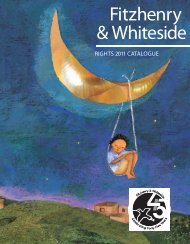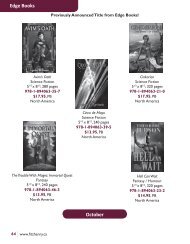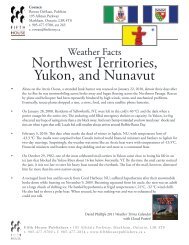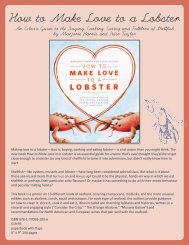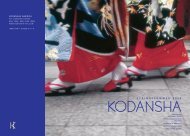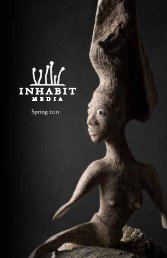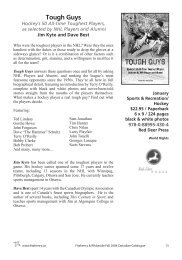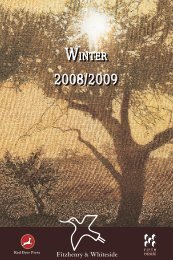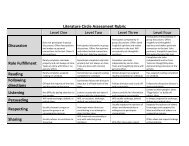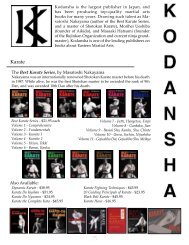EDUCATORS' GUIDE, “A Hare in the Elephant's Trunk”
EDUCATORS' GUIDE, “A Hare in the Elephant's Trunk”
EDUCATORS' GUIDE, “A Hare in the Elephant's Trunk”
Create successful ePaper yourself
Turn your PDF publications into a flip-book with our unique Google optimized e-Paper software.
Educators’ Guide
EDUCATORS’ <strong>GUIDE</strong>, <strong>“A</strong> <strong>Hare</strong> <strong>in</strong> <strong>the</strong> Elephant’s <strong>Trunk”</strong> 2<br />
EDUCATORS’ <strong>GUIDE</strong><br />
A HARE IN THE ELEPHANT’S TRUNK<br />
By: Jan L. Coates<br />
OUTLINE:<br />
Prologue<br />
BOOK I (pre-war life, Duk Padiet) — Pages 5–35, Chapters 1–4<br />
BOOK II (walk<strong>in</strong>g) — Pages 35–87, Chapters 5–9<br />
BOOK III (P<strong>in</strong>yudo) — Pages 89–148, Chapters 10–15<br />
BOOK IV (Pochalla/Kakuma) — Pages 149–230, Chapters 16–24<br />
BOOK V (leav<strong>in</strong>g Kakuma/Nairobi) — Pages 231–274, Chapters 25–27<br />
INTERVIEWS: Jan Coates, Jacob Akech Deng<br />
GLOSSARY<br />
SONGS: Pages 19, 25, 27, 54, 162, 168, 187, 232, 273<br />
CONVERSATIONS WITH MAMA: Pages 40, 75, 94/95, 103, 131,146, 153, 166,<br />
183, 198, 214, 219, 229, 238, 273, 274<br />
NOTE: Many of <strong>the</strong>se activities/discussions may be conducted <strong>in</strong> small groups, with an<br />
assigned recorder, speaker and moderator, if desired.
EDUCATORS’ <strong>GUIDE</strong>, <strong>“A</strong> <strong>Hare</strong> <strong>in</strong> <strong>the</strong> Elephant’s <strong>Trunk”</strong> 3<br />
PROLOGUE (pp. 1–3)<br />
Although <strong>the</strong> prologue is only two pages long, a lot of <strong>in</strong>formation is packed<br />
<strong>in</strong>to those two pages. What do you learn about <strong>the</strong> characters, tone and<br />
sett<strong>in</strong>g of <strong>the</strong> story from read<strong>in</strong>g <strong>the</strong> prologue?<br />
BOOK I (pp. 5–34)<br />
Jacob is seven years old and liv<strong>in</strong>g a peaceful life <strong>in</strong> <strong>the</strong> D<strong>in</strong>ka village of Duk<br />
Padiet, Sudan when <strong>the</strong> story beg<strong>in</strong>s <strong>in</strong> 1987. He lives with his mo<strong>the</strong>r,<br />
grandmo<strong>the</strong>r and sisters and spends his time play<strong>in</strong>g with his friend, Oscar,<br />
help<strong>in</strong>g his Uncle Daniel care for his cattle, look<strong>in</strong>g after his family’s goats and<br />
crops, and engag<strong>in</strong>g <strong>in</strong> storytell<strong>in</strong>g. His goals <strong>in</strong> life <strong>in</strong>clude becom<strong>in</strong>g a<br />
champion wrestler, like Uncle Daniel, and becom<strong>in</strong>g a soldier. His mo<strong>the</strong>r<br />
presents him with a precious gift, a blue Mama stone, which becomes his<br />
talisman. She also tells him “wadeng,” a D<strong>in</strong>ka word mean<strong>in</strong>g “look to<br />
tomorrow; it will be better,” and she expresses her wish that he and Sissy will<br />
both one day go to school.<br />
PRE-READING ACTIVITIES:<br />
• Judg<strong>in</strong>g from <strong>the</strong> cover and <strong>the</strong> title, what do you th<strong>in</strong>k <strong>the</strong> book will be<br />
about?<br />
• The circumstances <strong>in</strong> this book arose as a result of civil war <strong>in</strong> Sudan.<br />
Do you know of o<strong>the</strong>r civil wars that have taken place, or are tak<strong>in</strong>g<br />
place right now <strong>in</strong> <strong>the</strong> world? Discuss.<br />
• F<strong>in</strong>d a scale map that <strong>in</strong>cludes Sudan, Ethiopia and Kenya. Us<strong>in</strong>g <strong>the</strong><br />
map <strong>in</strong> <strong>the</strong> book, estimate <strong>the</strong> number of kilometers from Duk Padiet to<br />
P<strong>in</strong>yudo, and from P<strong>in</strong>yudo to Kakuma, via Pochalla. F<strong>in</strong>ally, estimate<br />
<strong>the</strong> distance from Kakuma to Nairobi.
EDUCATORS’ <strong>GUIDE</strong>, <strong>“A</strong> <strong>Hare</strong> <strong>in</strong> <strong>the</strong> Elephant’s <strong>Trunk”</strong> 4<br />
POST-READING:<br />
What is a prologue? Why do you th<strong>in</strong>k <strong>the</strong> author chose to beg<strong>in</strong> this<br />
book with a prologue?<br />
In creat<strong>in</strong>g a sett<strong>in</strong>g, authors are careful to <strong>in</strong>corporate all five senses <strong>in</strong><br />
<strong>the</strong>ir writ<strong>in</strong>g. F<strong>in</strong>d examples where this author has <strong>in</strong>volved each of <strong>the</strong><br />
senses <strong>in</strong> her writ<strong>in</strong>g. Discuss how <strong>the</strong> use of all five senses <strong>in</strong> her<br />
writ<strong>in</strong>g allows <strong>the</strong> reader to become part of <strong>the</strong> story, even when <strong>the</strong><br />
story is <strong>in</strong> an unfamiliar place.<br />
Def<strong>in</strong>e <strong>the</strong> word “talisman.” In Book I, what does Jacob acquire that<br />
becomes his talisman? Do you have someth<strong>in</strong>g like that <strong>in</strong> your life?<br />
Def<strong>in</strong>e <strong>the</strong> D<strong>in</strong>ka word, “wadeng.” Does a similar word or phrase exist<br />
<strong>in</strong> English? Try comb<strong>in</strong><strong>in</strong>g a couple of English words to see if you can<br />
<strong>in</strong>vent a word with such a mean<strong>in</strong>g.<br />
See if you can figure out a mean<strong>in</strong>g for <strong>the</strong> D<strong>in</strong>ka word “cieng.” Check<br />
<strong>the</strong> glossary at <strong>the</strong> back if you’re stuck.<br />
Beg<strong>in</strong> a character balloon web (attached) show<strong>in</strong>g <strong>the</strong> characters <strong>in</strong> this<br />
novel, with Jacob at its centre. In po<strong>in</strong>t form, <strong>in</strong>dicate <strong>the</strong> person’s<br />
importance to <strong>the</strong> story. Add balloons as new characters are <strong>in</strong>troduced.<br />
OTHER THINKING…<br />
‣ The “Big Fish” story is a family story, particular to Jacob’s family.<br />
Discuss any family stories/legends that may exist <strong>in</strong> your family. Are<br />
such family legends always 100% true, or do <strong>the</strong>y “grow” over time?<br />
‣ Discuss <strong>the</strong> conflict between what Jacob wants to do with his life (at<br />
<strong>the</strong> young age of 7) and his mo<strong>the</strong>r’s goal for him. Th<strong>in</strong>k of a situation<br />
<strong>in</strong> your own life — are <strong>the</strong>re th<strong>in</strong>gs your parents want you to do that<br />
you’re reluctant to do?<br />
‣ Discuss similarities between your life and Jacob’s life <strong>in</strong> Sudan. Th<strong>in</strong>k<br />
of family, home, sibl<strong>in</strong>gs, activities and food. Create a Venn diagram<br />
(attached) or chart show<strong>in</strong>g <strong>the</strong> similarities and differences between<br />
your life and Jacob’s <strong>in</strong> Book I.
EDUCATORS’ <strong>GUIDE</strong>, <strong>“A</strong> <strong>Hare</strong> <strong>in</strong> <strong>the</strong> Elephant’s <strong>Trunk”</strong> 5<br />
BOOK II (pp. 35–87)<br />
In <strong>the</strong> middle of <strong>the</strong> night, war arrives <strong>in</strong> Duk Padiet. Jacob’s life will never be<br />
<strong>the</strong> same. He looks frantically for his family amidst <strong>the</strong> burn<strong>in</strong>g ru<strong>in</strong>s of his<br />
village. He is found by his older nephew, Monyroor, who pulls him away <strong>in</strong>to<br />
<strong>the</strong> woods. They beg<strong>in</strong> walk<strong>in</strong>g <strong>in</strong> <strong>the</strong> direction of <strong>the</strong> ris<strong>in</strong>g sun, toward<br />
Ethiopia, where Monyroor has heard <strong>the</strong>y will be safe.<br />
Along <strong>the</strong> way, <strong>the</strong>y meet an elder named Mat<strong>the</strong>w and his<br />
granddaughter, Louise. They spend <strong>the</strong> night <strong>in</strong> ano<strong>the</strong>r destroyed village<br />
where <strong>the</strong>y meet a small boy named Willy, who is all alone. Willy chooses to<br />
stay <strong>in</strong> <strong>the</strong> village and wait for his family to return. Jacob, Monyroor,<br />
Mat<strong>the</strong>w and Louise cont<strong>in</strong>ue walk<strong>in</strong>g. When <strong>the</strong>y come upon a long<br />
centipede of walk<strong>in</strong>g boys, <strong>the</strong>y jo<strong>in</strong> <strong>the</strong>m and Jacob is reunited with Oscar,<br />
who has a badly <strong>in</strong>jured arm, and his know-it-all enemy, Majok, who assures<br />
<strong>the</strong>m <strong>the</strong>re will be plenty of food and shelter <strong>in</strong> Ethiopia. Mat<strong>the</strong>w and<br />
Louise are unable to keep up with <strong>the</strong> group and stay beh<strong>in</strong>d.<br />
After many days, <strong>the</strong> centipede arrives back <strong>in</strong> Willy’s village — <strong>the</strong>y<br />
have been walk<strong>in</strong>g <strong>in</strong> circles as <strong>the</strong>re are no po<strong>in</strong>ts of reference <strong>in</strong> <strong>the</strong> desert.<br />
Willy jo<strong>in</strong>s Jacob, Monyroor and Oscar and <strong>the</strong>y walk for several more weeks.<br />
The Sudan People’s Liberation Army (SPLA) sometimes stops by, recruit<strong>in</strong>g<br />
young soldiers, but <strong>the</strong> boys resist. After more than three months of walk<strong>in</strong>g,<br />
<strong>the</strong> boys arrive at <strong>the</strong> River Gilo, which <strong>the</strong>y must cross to get to Ethiopia.<br />
Willy is unable to swim, and Oscar can’t swim because of his <strong>in</strong>jured arm.<br />
PRE-READING ACTIVITIES:<br />
• What do you th<strong>in</strong>k is about to happen as Book II beg<strong>in</strong>s? Why do you<br />
th<strong>in</strong>k that?<br />
• Did <strong>the</strong> Book I give you any h<strong>in</strong>ts as to <strong>the</strong> significance of <strong>the</strong> title, A<br />
<strong>Hare</strong> <strong>in</strong> <strong>the</strong> Elephant’s Trunk? Expla<strong>in</strong>.<br />
POST-READING:<br />
If you were Jacob, would you have run away with Monyroor or would<br />
you have stayed to look for your mo<strong>the</strong>r, grandmo<strong>the</strong>r and sisters?<br />
Why?
EDUCATORS’ <strong>GUIDE</strong>, <strong>“A</strong> <strong>Hare</strong> <strong>in</strong> <strong>the</strong> Elephant’s <strong>Trunk”</strong> 6<br />
If you were suddenly forced to leave home, but you had just enough<br />
time to stuff ten items <strong>in</strong>to your backpack, what ten th<strong>in</strong>gs would you<br />
choose, and why?<br />
Read <strong>the</strong> song that Mat<strong>the</strong>w and <strong>the</strong> children s<strong>in</strong>g on page 54. Songs<br />
are an important part of D<strong>in</strong>ka culture. Expla<strong>in</strong> this song <strong>in</strong> terms of<br />
this story. Do you know of any similar English songs?<br />
A metaphor is a literary device used where<strong>in</strong> one object symbolizes<br />
ano<strong>the</strong>r, even though <strong>the</strong> two objects don’t really appear to have much<br />
<strong>in</strong> common. For example, “She was a volcano wait<strong>in</strong>g to blow,” is a<br />
metaphor. A person isn’t really a volcano, but through use of this<br />
metaphor, <strong>the</strong> writer enables <strong>the</strong> reader to immediately understand <strong>the</strong><br />
woman’s state of m<strong>in</strong>d. F<strong>in</strong>d as many examples of metaphors as you can<br />
<strong>in</strong> Book II.<br />
FURTHER THINKING…<br />
‣ Describe a time when you were extremely frustrated. Was <strong>the</strong> situation<br />
similar to what <strong>the</strong> boys would have experienced when <strong>the</strong>y came upon<br />
Willy aga<strong>in</strong> and realized <strong>the</strong>y had walked <strong>in</strong> a giant circle? Th<strong>in</strong>k of<br />
ano<strong>the</strong>r place <strong>in</strong> <strong>the</strong> world where this type of confusion could arise. The<br />
boys used <strong>the</strong> ris<strong>in</strong>g sun as a compass; can you th<strong>in</strong>k of someth<strong>in</strong>g else<br />
you might use to <strong>in</strong>dicate <strong>the</strong> direction <strong>in</strong> which you’re walk<strong>in</strong>g?<br />
‣ The boys become family <strong>in</strong> <strong>the</strong> course of this story. What<br />
characteristics do <strong>the</strong>y show toward each o<strong>the</strong>r that would make <strong>the</strong>m<br />
seem more like family than just friends (example: loyalty)?<br />
‣ As a way of ma<strong>in</strong>ta<strong>in</strong><strong>in</strong>g his connection with Mama, Jacob beg<strong>in</strong>s to talk<br />
to her <strong>in</strong>side his m<strong>in</strong>d (pages 40 and 74). Imag<strong>in</strong>e yourself <strong>in</strong> his<br />
situation and write a short letter to a significant person <strong>in</strong> your life.
EDUCATORS’ <strong>GUIDE</strong>, <strong>“A</strong> <strong>Hare</strong> <strong>in</strong> <strong>the</strong> Elephant’s <strong>Trunk”</strong> 7<br />
BOOK III (pp. 89–148)<br />
Jacob figures out that he and Oscar can lock arms and form a spider to travel<br />
across <strong>the</strong> River Gilo toge<strong>the</strong>r. Willy climbs onto Monyroor’s back and <strong>the</strong>y<br />
arrive safely <strong>in</strong> Ethiopia. They are very disappo<strong>in</strong>ted as it looks just as<br />
desolate as <strong>the</strong> Sudanese side <strong>the</strong>y left beh<strong>in</strong>d.<br />
They arrive at P<strong>in</strong>yudo Refugee Camp, which is be<strong>in</strong>g hastily assembled<br />
by <strong>the</strong> United Nations to accommodate <strong>the</strong> walk<strong>in</strong>g boys. They work to build<br />
shelters, and aid trucks arrive bear<strong>in</strong>g food and cloth<strong>in</strong>g. The boys are able to<br />
beg<strong>in</strong> attend<strong>in</strong>g a tree school with Teacher Mat<strong>the</strong>w, a D<strong>in</strong>ka man, who<br />
presents Jacob with his book of D<strong>in</strong>ka folktales, <strong>in</strong>vit<strong>in</strong>g him to learn to read<br />
<strong>the</strong> stories.<br />
Jacob becomes a keen student, although he does not want <strong>the</strong> o<strong>the</strong>r<br />
boys to know. He also becomes suspicious of Adam and <strong>the</strong> SPLA soldiers<br />
who are supposed to be help<strong>in</strong>g <strong>the</strong> Sudanese boys. His suspicions are<br />
confirmed when he witnesses Teacher Mat<strong>the</strong>w be<strong>in</strong>g attacked by Adam<br />
dur<strong>in</strong>g <strong>the</strong> robbery of a food truck headed for P<strong>in</strong>yudo. Jacob beg<strong>in</strong>s to<br />
believe Mat<strong>the</strong>w, who tells him education is <strong>the</strong> key to escape violence.<br />
PRE-READING ACTIVITIES:<br />
• What do you predict will happen <strong>in</strong> Book III? Will <strong>the</strong> boys make it<br />
safely to Ethiopia? What type of life will await <strong>the</strong>m <strong>the</strong>re?<br />
• Do you th<strong>in</strong>k all <strong>the</strong> ma<strong>in</strong> characters will be strong enough to survive<br />
<strong>the</strong>ir ordeal? Why or why not? Do you identify with one of <strong>the</strong><br />
characters more than <strong>the</strong> o<strong>the</strong>rs?<br />
• Have you ever been faced with a situation <strong>in</strong> which you were as scared<br />
as Willy when he realizes he needs to cross <strong>the</strong> big River Gilo and he is<br />
unable to swim? How did you solve your problem? Who helped you?<br />
POST- READING:<br />
Expla<strong>in</strong> Jacob’s conversation with Mama on page 94. To what is he<br />
referr<strong>in</strong>g when he mentions <strong>the</strong> stars?
EDUCATORS’ <strong>GUIDE</strong>, <strong>“A</strong> <strong>Hare</strong> <strong>in</strong> <strong>the</strong> Elephant’s <strong>Trunk”</strong> 8<br />
There are two African folktales <strong>in</strong> Book III: <strong>the</strong> story of <strong>the</strong> Elephant<br />
and <strong>the</strong> <strong>Hare</strong> (p. 126), as told by <strong>the</strong> elder to <strong>the</strong> boys at school, and<br />
Oscar’s joke about <strong>the</strong> K<strong>in</strong>g of <strong>the</strong> Beasts (p. 128). Choose one of <strong>the</strong>m<br />
and discuss why it is significant <strong>in</strong> this book. Do <strong>the</strong>se stories help you<br />
understand <strong>the</strong> title of <strong>the</strong> book? Expla<strong>in</strong>.<br />
What do you th<strong>in</strong>k of <strong>the</strong> soldier, Adam? What is his significance to<br />
<strong>the</strong> story? Write a paragraph describ<strong>in</strong>g him. Is he someone you would<br />
like to meet? Why or why not?<br />
The encounter between Teacher Mat<strong>the</strong>w and Adam takes place <strong>in</strong> <strong>the</strong><br />
center of <strong>the</strong> book — page 136–137. It is an important turn<strong>in</strong>g po<strong>in</strong>t for<br />
Jacob <strong>in</strong> <strong>the</strong> story — can you expla<strong>in</strong> why?<br />
FURTHER THINKING…<br />
‣ In a conversation with Mama on page 146, Jacob says: “…you would be<br />
surprised at how good I am gett<strong>in</strong>g at look<strong>in</strong>g after myself. But I am<br />
forgett<strong>in</strong>g <strong>the</strong> smell of groundnut stew cook<strong>in</strong>g, <strong>the</strong> rustl<strong>in</strong>g of<br />
Grandmo<strong>the</strong>r’s wr<strong>in</strong>kled hands weav<strong>in</strong>g grass, <strong>the</strong> music of your<br />
gr<strong>in</strong>d<strong>in</strong>g song…”<br />
a) Would your parents/guardians be surprised if you were able to<br />
look after yourself as <strong>the</strong>se boys do <strong>in</strong> such extreme<br />
circumstances?<br />
b) Th<strong>in</strong>k of several th<strong>in</strong>gs about your home that you would miss if<br />
you were plunged <strong>in</strong>to such a circumstance.<br />
‣ Folktales are often made up to expla<strong>in</strong> natural phenomena. An example<br />
is <strong>the</strong> story Jacob makes up about <strong>the</strong> elephant try<strong>in</strong>g to steal <strong>the</strong> honey<br />
and be<strong>in</strong>g chased by <strong>the</strong> bees. Forever after, <strong>the</strong> big elephant is scared<br />
of <strong>the</strong> t<strong>in</strong>y bees; <strong>in</strong> reality, elephants are very scared of bees and will run<br />
away from <strong>the</strong>ir buzz<strong>in</strong>g. Write and illustrate your own folktale to<br />
expla<strong>in</strong> someth<strong>in</strong>g <strong>in</strong>terest<strong>in</strong>g you know about <strong>in</strong> <strong>the</strong> natural world.<br />
‣ Several of <strong>the</strong> ma<strong>in</strong> characters <strong>in</strong> <strong>the</strong> novel are described through <strong>the</strong> use<br />
of an animal metaphor. What animal metaphor is used for each of <strong>the</strong><br />
follow<strong>in</strong>g: Jacob, Oscar, Willy, Monyroor, Adam? Give examples.
EDUCATORS’ <strong>GUIDE</strong>, <strong>“A</strong> <strong>Hare</strong> <strong>in</strong> <strong>the</strong> Elephant’s <strong>Trunk”</strong> 9<br />
BOOK IV (pp. 149–240)<br />
The boys are chased from Ethiopia due to civil unrest <strong>in</strong> that country. Oscar is<br />
lost <strong>in</strong> <strong>the</strong> River Gilo cross<strong>in</strong>g, and Jacob, out of frustration and grief, f<strong>in</strong>ally<br />
has a physical encounter with Majok. The boys spend a number of ra<strong>in</strong>y<br />
weeks <strong>in</strong> Pochalla, and <strong>the</strong>n beg<strong>in</strong> walk<strong>in</strong>g south toward Kenya, where a<br />
refugee camp is be<strong>in</strong>g built for <strong>the</strong>m. Monyroor is <strong>in</strong>jured dur<strong>in</strong>g an aerial<br />
bomb attack dur<strong>in</strong>g which Jacob also loses his precious Mama stone. When<br />
<strong>the</strong>y arrive at Lokichokio, near <strong>the</strong> Sudan/Kenya border, Monyroor disappears<br />
dur<strong>in</strong>g <strong>the</strong> night. He has made <strong>the</strong> decision to jo<strong>in</strong> Adam and <strong>the</strong> o<strong>the</strong>r SPLA<br />
soldiers.<br />
Jacob has ano<strong>the</strong>r encounter with Majok, only this time Jacob<br />
remembers Mat<strong>the</strong>w’s advice and recites <strong>the</strong> alphabet ra<strong>the</strong>r than fight<strong>in</strong>g<br />
with Majok aga<strong>in</strong>. Upon arriv<strong>in</strong>g <strong>in</strong> Kakuma Refugee Camp, <strong>the</strong> boys are<br />
f<strong>in</strong>ally reunited with Oscar, who miraculously survived <strong>the</strong> near-drown<strong>in</strong>g <strong>in</strong><br />
<strong>the</strong> Gilo cross<strong>in</strong>g. The Lost Boys, as <strong>the</strong>y have become known, cont<strong>in</strong>ue go<strong>in</strong>g<br />
to school, although <strong>the</strong>re is no sign of Teacher Mat<strong>the</strong>w. The new teacher,<br />
Chol, recognizes Jacob’s academic ability, and after Jacob places first <strong>in</strong> his<br />
exams, Chol offers him a job work<strong>in</strong>g as a translator.<br />
Eventually, rumors of <strong>the</strong> school’s closure lead some boys to leave<br />
Kakuma for board<strong>in</strong>g schools <strong>in</strong> Nairobi. Jacob decides he must take his<br />
belong<strong>in</strong>gs and return to Sudan <strong>in</strong> hopes of trad<strong>in</strong>g <strong>the</strong>m for money to pay for<br />
board<strong>in</strong>g school.<br />
PRE-READING ACTIVITIES:<br />
• Predict what is about to happen as Book IV starts. How would you feel<br />
<strong>in</strong> this situation?<br />
• Discuss <strong>the</strong> good and bad th<strong>in</strong>gs about life <strong>in</strong> P<strong>in</strong>yudo Refugee Camp.<br />
Can you imag<strong>in</strong>e go<strong>in</strong>g to school under a tree and writ<strong>in</strong>g with a stick <strong>in</strong><br />
<strong>the</strong> dirt?<br />
POST-READING:<br />
There are two D<strong>in</strong>ka songs <strong>the</strong> boys s<strong>in</strong>g <strong>in</strong> Book IV on pages 168 and<br />
187. Choose one of <strong>the</strong>m and expla<strong>in</strong> its significance to <strong>the</strong> story.
EDUCATORS’ <strong>GUIDE</strong>, <strong>“A</strong> <strong>Hare</strong> <strong>in</strong> <strong>the</strong> Elephant’s <strong>Trunk”</strong> 10<br />
On page 168, Jacob discovers he has lost his Mama stone, his talisman.<br />
The stone is a symbol of Jacob’s connection with his old life. Can you<br />
expla<strong>in</strong> <strong>the</strong> significance of him los<strong>in</strong>g it at this po<strong>in</strong>t <strong>in</strong> <strong>the</strong> story?<br />
Why do you th<strong>in</strong>k Monyroor decides to jo<strong>in</strong> <strong>the</strong> SPLA soldiers? Would<br />
you do <strong>the</strong> same th<strong>in</strong>g under <strong>the</strong> circumstances if you were a teenager?<br />
Do you admire Jacob for his refusal to fight with Majok a second time<br />
after <strong>the</strong> disappearance of Monyroor? Would you have done <strong>the</strong> same<br />
th<strong>in</strong>g?<br />
On page 177, Jacob says: <strong>“A</strong>nger is like a hungry elephant; <strong>the</strong> more it is<br />
fed, <strong>the</strong> more it wants to eat.” Expla<strong>in</strong> this quote <strong>in</strong> terms of <strong>the</strong><br />
elephant metaphor that occurs throughout <strong>the</strong> book.<br />
What factors comb<strong>in</strong>e to conv<strong>in</strong>ce Jacob that education is <strong>the</strong> path to<br />
peace, ra<strong>the</strong>r than more fight<strong>in</strong>g?<br />
FURTHER THINKING…<br />
‣ Does <strong>the</strong> song <strong>the</strong> boys s<strong>in</strong>g at <strong>the</strong> bottom of page 187 rem<strong>in</strong>d you of any<br />
songs you know? Talk about a song you know that has an important<br />
message for young people.<br />
‣ Jacob and Majok gradually come to terms with each o<strong>the</strong>r. Although<br />
<strong>the</strong>y are not actually friends, <strong>the</strong>y at least are no longer enemies and<br />
share a thirst for knowledge. If you were Jacob, would you have helped<br />
Majok when he feared he was about to lose his sight? Have you ever had<br />
an experience when you felt obliged to help somebody you didn’t really<br />
like? How did you react?<br />
‣ In North America, we take libraries for granted. Imag<strong>in</strong>e that you are<br />
Jacob, enter<strong>in</strong>g a library for <strong>the</strong> very first time. Write a couple of<br />
paragraphs describ<strong>in</strong>g your reaction; remember to use all of your senses.
EDUCATORS’ <strong>GUIDE</strong>, <strong>“A</strong> <strong>Hare</strong> <strong>in</strong> <strong>the</strong> Elephant’s <strong>Trunk”</strong> 11<br />
BOOK V (pp. 240–274)<br />
Jacob trades his school bag and cloth<strong>in</strong>g for five cones of tobacco,<br />
which are <strong>the</strong>n exchanged for five goats, which Jacob f<strong>in</strong>ally sells <strong>in</strong> a market.<br />
He returns to Kakuma, cash <strong>in</strong> hand, and quickly catches a ride to Nairobi.<br />
Once <strong>the</strong>re, he meets a young boy, Jabari, who helps him f<strong>in</strong>d a school.<br />
Unfortunately, <strong>the</strong> Headmaster tells Jacob he must have a note from a parent<br />
or guardian <strong>in</strong> order to be enrolled <strong>in</strong> <strong>the</strong> school. Jabari <strong>the</strong>n leads Jacob to<br />
Mathare Valley where <strong>the</strong>re are many refugees from all over Africa. While<br />
watch<strong>in</strong>g a wrestl<strong>in</strong>g match <strong>the</strong>re, Jacob spots his boyhood hero, Uncle<br />
Daniel. Uncle Daniel has given up be<strong>in</strong>g a soldier after los<strong>in</strong>g a leg to a<br />
landm<strong>in</strong>e. He signs <strong>the</strong> note of responsibility for Jacob and Jacob returns to<br />
Lasier Hill Academy.<br />
F<strong>in</strong>ally, as he lies <strong>in</strong> bed <strong>in</strong> <strong>the</strong> dorm, on <strong>the</strong> eve of his first day of school,<br />
he is able to hear <strong>the</strong> stars s<strong>in</strong>g<strong>in</strong>g over Africa, just as his beloved mo<strong>the</strong>r had<br />
promised.<br />
PRE-READING ACTIVITIES:<br />
• What do you th<strong>in</strong>k will happen to Jacob <strong>in</strong> <strong>the</strong> f<strong>in</strong>al chapters of this<br />
book as he returns to Sudan alone?<br />
• Do you th<strong>in</strong>k Jacob will be able to look after himself, apart from his<br />
friends? Why or why not?<br />
• If you were Jacob, would you have been brave enough to set out alone,<br />
know<strong>in</strong>g it would be ano<strong>the</strong>r long, dangerous journey?<br />
POST-READING:<br />
How does Jacob demonstrate that he is <strong>in</strong>deed a clever little hare <strong>in</strong><br />
<strong>the</strong>se chapters?<br />
Have you ever been reunited with someone important <strong>in</strong> your life, with<br />
whom you’ve lost touch? Compare that experience with Jacob’s feel<strong>in</strong>gs<br />
upon f<strong>in</strong>d<strong>in</strong>g Uncle Daniel aga<strong>in</strong>.
EDUCATORS’ <strong>GUIDE</strong>, <strong>“A</strong> <strong>Hare</strong> <strong>in</strong> <strong>the</strong> Elephant’s <strong>Trunk”</strong> 12<br />
Were you surprised by <strong>the</strong> end<strong>in</strong>g of <strong>the</strong> book? Was <strong>the</strong>re a certa<strong>in</strong><br />
po<strong>in</strong>t when you began to assume Jacob would not see Mama aga<strong>in</strong>?<br />
What about Monyroor?<br />
FURTHER THINKING…<br />
‣ Why were <strong>the</strong> walk<strong>in</strong>g boys called “The Lost Boys of Sudan?”<br />
‣ Why does gett<strong>in</strong>g an education become so important for Jacob? Is<br />
education important to you? Would it be more important if it was not<br />
easily available to you?<br />
‣ Read <strong>the</strong> <strong>in</strong>terviews with <strong>the</strong> author and Jacob Deng at <strong>the</strong> back of <strong>the</strong><br />
book. Use <strong>the</strong> <strong>in</strong>ternet to f<strong>in</strong>d out more <strong>in</strong>formation about <strong>the</strong>m.<br />
‣ A term that might be used to describe this type of book is “faction.”<br />
What do you th<strong>in</strong>k this term means? Have you read o<strong>the</strong>r books that<br />
would also be considered “faction?”<br />
‣ Are <strong>the</strong>re th<strong>in</strong>gs you would have done differently if you had written this<br />
book? Consider plot, sett<strong>in</strong>g, characters, resolution of conflict, po<strong>in</strong>t of<br />
view, etc.<br />
‣ Without conflict, <strong>the</strong>re is no story. What is <strong>the</strong> central conflict <strong>in</strong> this<br />
book? Draw a graph of <strong>the</strong> story arc <strong>in</strong> this novel, show<strong>in</strong>g <strong>the</strong> various<br />
crises as <strong>the</strong> high parts <strong>in</strong> <strong>the</strong> narrative arc. Can you determ<strong>in</strong>e through<br />
creat<strong>in</strong>g <strong>the</strong> graph what <strong>the</strong> crucial turn<strong>in</strong>g po<strong>in</strong>t is for Jacob; <strong>the</strong> “po<strong>in</strong>t<br />
of no return” ?
EDUCATORS’ <strong>GUIDE</strong>, <strong>“A</strong> <strong>Hare</strong> <strong>in</strong> <strong>the</strong> Elephant’s <strong>Trunk”</strong> 13<br />
CREATIVE PROJECTS:<br />
• Design a board game based on A <strong>Hare</strong> <strong>in</strong> <strong>the</strong> Elephant’s Trunk. If you<br />
picture a Monopoly-style game, perhaps <strong>the</strong> four corners could be Duk<br />
Padiet, P<strong>in</strong>yudo Refugee Camp, Kakuma Refugee Camp and Nairobi.<br />
You could have a mixture of good and bad events on <strong>the</strong> squares<br />
(example: crocodile attack, go back two squares) and for markers, you<br />
might want to use Jacob and his friends.<br />
• Create a PowerPo<strong>in</strong>t about “The Lost Boys of Sudan.” F<strong>in</strong>d images on<br />
<strong>the</strong> Internet and blend <strong>the</strong>m with quotes from <strong>the</strong> book. F<strong>in</strong>d a suitable<br />
song to accompany your PowerPo<strong>in</strong>t.<br />
• Research Wadeng W<strong>in</strong>gs of Hope (www.wadeng.org), <strong>the</strong> charitable<br />
foundation Jacob started to raise money to build a school <strong>in</strong> Duk Padiet.<br />
Design a poster to advertise <strong>the</strong> foundation.<br />
• Write a letter to <strong>the</strong> author and Jacob. Expla<strong>in</strong> your reactions to <strong>the</strong><br />
book and review <strong>the</strong> book. Search for professional reviews of <strong>the</strong> book<br />
onl<strong>in</strong>e to use as examples (example: Kirkus Reviews; Booklist; School<br />
Library Journal; CM Reviews).<br />
• Complete <strong>the</strong> Character Questionnaire (attached) for one of <strong>the</strong><br />
characters <strong>in</strong> <strong>the</strong> novel. Complete a second questionnaire for a new<br />
character, created by you, who might fit <strong>in</strong>to this novel. Expla<strong>in</strong> his/her<br />
role.<br />
• Choose your favorite scene, or scenes, <strong>in</strong> <strong>the</strong> book. Write a detailed<br />
dialogue that may have taken place dur<strong>in</strong>g that scene. Ei<strong>the</strong>r make a<br />
film of your script or give a dramatic presentation <strong>in</strong> class. You can<br />
choose to write it <strong>in</strong> <strong>the</strong> style of language you would use, or <strong>in</strong> <strong>the</strong> style<br />
of language Jacob and his friends use.<br />
• Select a quote from <strong>the</strong> book and create a work of art (sculpture,<br />
pa<strong>in</strong>t<strong>in</strong>g, draw<strong>in</strong>g, collage, etc.) to illustrate that quote. Incorporate <strong>the</strong><br />
words of <strong>the</strong> quote <strong>in</strong>to your creation.
EDUCATORS’ <strong>GUIDE</strong>, <strong>“A</strong> <strong>Hare</strong> <strong>in</strong> <strong>the</strong> Elephant’s <strong>Trunk”</strong> 14<br />
• Choose a part of <strong>the</strong> book where<strong>in</strong> one character had to make a<br />
decision; analyze that decision, us<strong>in</strong>g <strong>the</strong> attached Decision Chart. In<br />
an essay, talk about whe<strong>the</strong>r you would have made <strong>the</strong> same decision,<br />
and <strong>the</strong> reasons for your decision.<br />
• When <strong>the</strong> author orig<strong>in</strong>ally <strong>in</strong>terviewed Jacob Deng, he told her <strong>the</strong><br />
follow<strong>in</strong>g: “We cannot choose where we are born, or <strong>the</strong> life we are<br />
born <strong>in</strong>to, but we can choose what to do with <strong>the</strong> life we are given.”<br />
Now that you have read <strong>the</strong> novel based on Jacob’s life, discuss this<br />
quote as it relates to his life.<br />
• Use <strong>the</strong> <strong>in</strong>ternet to research ano<strong>the</strong>r area <strong>in</strong> <strong>the</strong> world where many<br />
people live <strong>in</strong> a refugee camp. Write a short story about a child liv<strong>in</strong>g <strong>in</strong><br />
that refugee camp.<br />
• Design a fundrais<strong>in</strong>g event or campaign to help Wadeng W<strong>in</strong>gs of Hope<br />
build a school <strong>in</strong> Sudan. You may want to <strong>in</strong>clude a logo, slogan, poster,<br />
<strong>in</strong>vitation, and a list of jobs <strong>in</strong>volved <strong>in</strong> organiz<strong>in</strong>g such an event.<br />
• Discuss and give examples from this book of each of <strong>the</strong> follow<strong>in</strong>g<br />
literary devices: simile, imagery, metaphor, symbolism, alliteration,<br />
<strong>the</strong>me.<br />
• Create two columns with opposite-word head<strong>in</strong>gs (examples: hate/<br />
love; peace/violence; power/submission; honesty/deceit). Now, f<strong>in</strong>d five<br />
elements <strong>in</strong> <strong>the</strong> novel that fit <strong>the</strong> descriptive words. Are <strong>the</strong>re more<br />
positive or negative elements, or is <strong>the</strong>re a balance?<br />
• Research <strong>the</strong> issue of child soldiers. In <strong>the</strong> novel, Monyroor chose to<br />
jo<strong>in</strong> <strong>the</strong> soldiers. Do you agree with his decision? Why or why not?<br />
• Create a political cartoon about The Lost Boys of Sudan and <strong>the</strong> refugee<br />
camp experience.<br />
• Write an acrostic poem based on <strong>the</strong> novel, us<strong>in</strong>g <strong>the</strong> letters <strong>in</strong> <strong>the</strong> title<br />
– A HARE IN THE ELEPHANT’S TRUNK.
EDUCATORS’ <strong>GUIDE</strong>, <strong>“A</strong> <strong>Hare</strong> <strong>in</strong> <strong>the</strong> Elephant’s <strong>Trunk”</strong> 15<br />
CHARACTER QUESTIONNAIRE<br />
Name:<br />
Nickname (if any):<br />
K<strong>in</strong>d of be<strong>in</strong>g (human, animal, fairytale, extraterrestrial, fantasy):<br />
Age:<br />
Gender:<br />
Appearance:<br />
Occupation:<br />
Family members:<br />
Pets:<br />
Best friend:<br />
Describe his/her room:<br />
Way of speak<strong>in</strong>g (speed, unusual mannerisms):<br />
Physical characteristics (posture, gestures, attitude):<br />
Items <strong>in</strong> backpack/purse:<br />
Hobbies:<br />
Favorite sport:<br />
Talents, abilities, powers:<br />
Relationships (how he/she is with o<strong>the</strong>r people):<br />
Fears:<br />
Faults:<br />
Good po<strong>in</strong>ts:<br />
Problems <strong>in</strong> his/her life:<br />
What he/she wants more than anyth<strong>in</strong>g else:
EDUCATORS’ <strong>GUIDE</strong>, <strong>“A</strong> <strong>Hare</strong> <strong>in</strong> <strong>the</strong> Elephant’s <strong>Trunk”</strong> 16<br />
A HARE IN THE ELEPHANT'S TRUNK<br />
Glossary Word Search<br />
U X V K C N Q H Q G N J G F K<br />
R S H R P P M L P R D N R I C<br />
F O P P O M B K T A B C S H A<br />
F U R S A L A C N A M R D L L<br />
G K L C G I N E E G A U I I A<br />
O N G U O O Y Z B K D B N U B<br />
U V E R K R C O T U N O K H A<br />
R C G D A U Q R K O K O A O S<br />
W O I A A W T I O H O B X M H<br />
T A B E E W L U A K J A Q U Q<br />
V A V C N W R W A G U H W U C<br />
A V H B A G A E M X Q I M H S<br />
W Y H C U J C Z J U Z W B J I<br />
T U D N A C K R Y Y T T K Y P<br />
A N Y O K A N N A M Y I P H F<br />
ABAAR ANYOK CALABASH CIENG<br />
DINKA GAAR HABOOB KHAWAJA<br />
KISRA KUDU LUAK MANCALA<br />
MANNA MUTI SOUK TOC<br />
TUKUL WADENG WECH
EDUCATORS’ <strong>GUIDE</strong>, <strong>“A</strong> <strong>Hare</strong> <strong>in</strong> <strong>the</strong> Elephant’s <strong>Trunk”</strong> 17<br />
SOLUTION<br />
+ + + + + + + + + + + + + + K<br />
+ S + + + + + + + R + + + I C<br />
+ O + + + + + + + A + + S + A<br />
+ U + + A L A C N A M R D + L<br />
G K L + + + + + + G A U I + A<br />
+ N + U + + + + + + D B N + B<br />
+ + E + K R C O T U + O K + A<br />
+ C + D A U + + K + K O A + S<br />
+ + I A A W T + + H + B + + H<br />
+ + B E E W L U A K + A + + +<br />
+ A + C N + + W + + + H + + +<br />
+ + H + + G A + M + + + + + +<br />
+ + + + + J + + + U + + + + +<br />
+ + + + A + + + + + T + + + +<br />
A N Y O K A N N A M + I + + +<br />
(Over,Down,Direction)<br />
ABAAR(2,11,NE)<br />
ANYOK(1,15,E)<br />
CALABASH(15,2,S)<br />
CIENG(2,8,SE)<br />
DINKA(13,4,S)<br />
GAAR(10,5,N)<br />
HABOOB(12,11,N)<br />
KHAWAJA(11,8,SW)<br />
KISRA(15,1,SW)<br />
KUDU(9,8,NE)<br />
LUAK(7,10,E)<br />
MANCALA(11,4,W)<br />
MANNA(10,15,W)<br />
MUTI(9,12,SE)<br />
SOUK(2,2,S)<br />
TOC(9,7,W)<br />
TUKUL(7,9,NW)<br />
WADENG(6,10,NW)<br />
WECH(6,9,SW)
EDUCATORS’ <strong>GUIDE</strong>, <strong>“A</strong> <strong>Hare</strong> <strong>in</strong> <strong>the</strong> Elephant’s <strong>Trunk”</strong> 18<br />
GRADE 9 ELA OUTCOMES (Nova Scotia): YEARLY PLANNING CHART<br />
(Outcomes marked with a ☺can be met through us<strong>in</strong>g this educators’ guide)<br />
Speak<strong>in</strong>g and Listen<strong>in</strong>g<br />
GCO 1: Uses oral language to learn<br />
GCO 2: Communicates us<strong>in</strong>g clear oral<br />
communication<br />
1.1 Re<strong>in</strong>forces or<br />
develops new<br />
understand<strong>in</strong>g from what<br />
o<strong>the</strong>rs share<br />
☺<br />
1.2 Asks<br />
questions for<br />
clarification, for<br />
elaboration, to<br />
qualify, or to<br />
question<br />
relevance,<br />
accuracy,<br />
validity<br />
☺<br />
1.3<br />
Thoughtfully<br />
answers<br />
questions<br />
asked by<br />
o<strong>the</strong>rs <strong>in</strong> order<br />
to clarify or<br />
give more<br />
<strong>in</strong>formation<br />
☺<br />
1.4 Expla<strong>in</strong>s<br />
and advocates<br />
po<strong>in</strong>t of view<br />
and supports it<br />
with evidence<br />
from various<br />
sources<br />
☺<br />
1.5 Listen<br />
critically and<br />
determ<strong>in</strong>es <strong>the</strong><br />
effectiveness of<br />
<strong>the</strong> speaker<br />
based on<br />
accuracy and<br />
appropriateness<br />
of <strong>in</strong>formation<br />
2.1<br />
Contributes<br />
to small<br />
group and<br />
whole group<br />
discussions<br />
us<strong>in</strong>g a<br />
variety of<br />
strategies<br />
☺<br />
2.2 Uses<br />
appropriate<br />
vocabulary,<br />
sentence<br />
structure, tone,<br />
speed for <strong>the</strong><br />
audience<br />
☺<br />
2.3 Gives<br />
<strong>in</strong>structions<br />
GCO 2 cont<strong>in</strong>ued: Communicates us<strong>in</strong>g clear oral<br />
communication<br />
GCO 3: Interacts with sensitivity and respect<br />
2.4 Responds to<br />
questions and follows<br />
complex directions<br />
2.5 Evaluates<br />
effectiveness of<br />
own and o<strong>the</strong>rs<br />
talk, recogniz<strong>in</strong>g<br />
<strong>the</strong> effects of<br />
verbal and<br />
nonverbal<br />
features<br />
☺<br />
2.6 Understands<br />
how<br />
mean<strong>in</strong>g is<br />
affected by<br />
verbal and<br />
non-verbal<br />
cues (repetition,<br />
eye<br />
contact,<br />
volume)<br />
3.1 Demonstrates<br />
active<br />
listen<strong>in</strong>g (eye<br />
contact,<br />
rephras<strong>in</strong>g,<br />
clarify<strong>in</strong>g,<br />
extend, ref<strong>in</strong>e,<br />
summarize)<br />
☺<br />
3.2 Shows<br />
respect for<br />
o<strong>the</strong>rs when<br />
giv<strong>in</strong>g personal<br />
op<strong>in</strong>ions<br />
☺<br />
3.3 Recognizes<br />
values,<br />
attitudes,<br />
bias, beliefs<br />
and prejudice<br />
<strong>in</strong><br />
spoken<br />
language<br />
3.4 Demonstrates<br />
awareness<br />
of <strong>the</strong> power of<br />
language to<br />
<strong>in</strong>fluence and<br />
manipulate, to<br />
reveal values<br />
and attitudes<br />
☺<br />
3.5 Knows that<br />
different situations<br />
require different<br />
conventions and<br />
uses language<br />
appropriate to <strong>the</strong><br />
situation
EDUCATORS’ <strong>GUIDE</strong>, <strong>“A</strong> <strong>Hare</strong> <strong>in</strong> <strong>the</strong> Elephant’s <strong>Trunk”</strong> 19<br />
Read<strong>in</strong>g and View<strong>in</strong>g<br />
GCO 4: Reads widely and with understand<strong>in</strong>g<br />
GCO 5: Conducts research<br />
4.1 Selects texts<br />
that meet needs<br />
and <strong>in</strong>terests<br />
4.2 Reads a<br />
variety of texts<br />
(fiction, non<br />
fiction, media<br />
text) from<br />
different<br />
prov<strong>in</strong>ces and<br />
countries<br />
☺<br />
4.3 Expla<strong>in</strong>s<br />
how authors<br />
use text<br />
features to<br />
create<br />
mean<strong>in</strong>g<br />
and achieve<br />
different<br />
purposes<br />
☺<br />
4.4 Uses<br />
text features<br />
to<br />
construct<br />
mean<strong>in</strong>g<br />
☺<br />
4.5 Reads<br />
complex<br />
text with<br />
greater<br />
fluency,<br />
confidence,<br />
and<br />
comprehension<br />
due to<br />
use of<br />
cu<strong>in</strong>g<br />
systems<br />
4.6 Independently<br />
uses<br />
read<strong>in</strong>g<br />
strategies<br />
(predict<strong>in</strong>g,<br />
connect<strong>in</strong>g,<br />
question<strong>in</strong>g,<br />
<strong>in</strong>ferr<strong>in</strong>g,<br />
visualiz<strong>in</strong>g,<br />
syn<strong>the</strong>siz<strong>in</strong>g)<br />
☺<br />
4.7 Consistently<br />
identifies<br />
and discusses<br />
<strong>the</strong> k<strong>in</strong>ds<br />
of strategies<br />
good<br />
readers<br />
and<br />
viewers<br />
use<br />
4.8 Reflects<br />
on<br />
own<br />
read<strong>in</strong>g<br />
and<br />
view<strong>in</strong>g<br />
strategies<br />
and<br />
makes<br />
necessary<br />
adjustments<br />
5.1 Identifies<br />
relevance<br />
<strong>in</strong><br />
<strong>in</strong>terest<strong>in</strong>g<br />
topics or<br />
questions<br />
for study<br />
☺<br />
5.2 Recognizes<br />
<strong>the</strong> need for<br />
additional<br />
<strong>in</strong>formation to<br />
meet learn<strong>in</strong>g<br />
needs<br />
GCO 5 cont<strong>in</strong>ued: Conducts<br />
research<br />
GCO 6: Responds<br />
personally<br />
GCO 7: Reads critically<br />
5.3 Independently<br />
locates <strong>in</strong>formation from<br />
a variety of pr<strong>in</strong>t and<br />
non-pr<strong>in</strong>t sources with<br />
speed, accuracy, and<br />
confidence<br />
☺<br />
5.4 Ref<strong>in</strong>es<br />
research<br />
strategies<br />
6.1 Goes<br />
beyond<br />
<strong>in</strong>itial<br />
response to<br />
give more<br />
thoughtful<br />
<strong>in</strong>terpretations<br />
by<br />
question<strong>in</strong>g,<br />
connect<strong>in</strong>g,<br />
evaluat<strong>in</strong>g,<br />
extend<strong>in</strong>g<br />
☺<br />
6.2 Supports<br />
personal<br />
response<br />
to <strong>the</strong><br />
issues,<br />
<strong>the</strong>mes,<br />
and<br />
situations<br />
and gives<br />
personal<br />
examples<br />
or evidence<br />
from text<br />
with <strong>in</strong>creas<strong>in</strong>g<br />
sophistication<br />
7.1 Evaluates<br />
pr<strong>in</strong>t<br />
and media<br />
texts for<br />
bias<br />
7.2 Evaluates<br />
<strong>the</strong><br />
relevance<br />
and<br />
reliability<br />
of content<br />
7.3 Recognizes<br />
<strong>in</strong>creas<strong>in</strong>gly<br />
complex<br />
tools<br />
authors use<br />
(organization<br />
of <strong>in</strong>fo,<br />
word<br />
choice, use<br />
of time,<br />
imagery,<br />
etc.)<br />
☺<br />
7.4 Evaluates<br />
<strong>the</strong><br />
impact<br />
that text<br />
form,<br />
content,<br />
and<br />
structure<br />
have on<br />
mean<strong>in</strong>g<br />
☺<br />
7.5 Understands<br />
that<br />
values and<br />
personal<br />
experience<br />
<strong>in</strong>fluences<br />
understand<strong>in</strong>g<br />
and<br />
critical<br />
response<br />
☺<br />
7.6 Evaluates <strong>the</strong><br />
portrayal of<br />
culture and reality<br />
as portrayed <strong>in</strong><br />
media text<br />
☺<br />
☺
EDUCATORS’ <strong>GUIDE</strong>, <strong>“A</strong> <strong>Hare</strong> <strong>in</strong> <strong>the</strong> Elephant’s <strong>Trunk”</strong> 20<br />
Writ<strong>in</strong>g and Represent<strong>in</strong>g<br />
GCO 8: Uses many k<strong>in</strong>ds of writ<strong>in</strong>g to th<strong>in</strong>k and learn<br />
GCO 9: Creates a variety of texts<br />
8.1 Uses a range of strategies<br />
as a language learner<br />
☺<br />
8.2 Writes for a<br />
variety of reasons<br />
☺<br />
8.3 Reflects on<br />
writ<strong>in</strong>g strategies<br />
that help him/her<br />
learn or have<br />
personal growth as<br />
a language learner<br />
8.4 Uses a<br />
variety of forms<br />
of note mak<strong>in</strong>g<br />
for different<br />
purposes and<br />
situations<br />
8.5 Uses<br />
<strong>in</strong>terest<strong>in</strong>g<br />
effects <strong>in</strong> writ<strong>in</strong>g<br />
(feel<strong>in</strong>gs and<br />
thoughts, detail,<br />
correct<br />
<strong>in</strong>consistency,<br />
avoid extraneous<br />
detail, language<br />
choice,<br />
vocabulary and<br />
phras<strong>in</strong>g<br />
9.1 Cont<strong>in</strong>ues to<br />
use a variety of<br />
forms as well as<br />
o<strong>the</strong>r art forms<br />
☺<br />
9.2 Considers and<br />
crafts writ<strong>in</strong>g (content,<br />
word choice, style,<br />
tone, form, structure,<br />
organization) to suit<br />
purpose and audience<br />
☺<br />
☺<br />
GCO 9 cont<strong>in</strong>ued: Creates a variety of texts<br />
GCO 10: Produces clear and effective writ<strong>in</strong>g and o<strong>the</strong>r representations<br />
9.3 Experiments with<br />
represent<strong>in</strong>g ideas <strong>in</strong> many<br />
ways (dialogue, ads, posters)<br />
☺<br />
9.4 Analyzes and<br />
assesses<br />
feedback about<br />
writ<strong>in</strong>g and apply<br />
it to future drafts<br />
10.1 Consistently<br />
uses conventions of<br />
written language <strong>in</strong><br />
f<strong>in</strong>al products<br />
☺<br />
10.2 Chooses<br />
and applies <strong>the</strong><br />
appropriate<br />
prewrit<strong>in</strong>g,<br />
draft<strong>in</strong>g,<br />
revis<strong>in</strong>g, edit<strong>in</strong>g,<br />
proofread<strong>in</strong>g,<br />
and presentation<br />
strategies<br />
10.3 Acquires<br />
some exposure<br />
to various<br />
technologies<br />
(video, email,<br />
word process<strong>in</strong>g,<br />
audio tape)<br />
10.4 Shows<br />
commitment to<br />
craft<strong>in</strong>g writ<strong>in</strong>g<br />
and o<strong>the</strong>r<br />
representations<br />
10.5 Collects<br />
<strong>in</strong>formation from<br />
several sources<br />
(<strong>in</strong>terview, film, CD,<br />
text) and comb<strong>in</strong>es <strong>in</strong><br />
communication<br />
☺<br />
☺<br />
☺<br />
☺
EDUCATORS’ <strong>GUIDE</strong>, <strong>“A</strong> <strong>Hare</strong> <strong>in</strong> <strong>the</strong> Elephant’s <strong>Trunk”</strong> 21<br />
CHARACTER BALLOONS<br />
(Draw more, if required)
EDUCATORS’ <strong>GUIDE</strong>, <strong>“A</strong> <strong>Hare</strong> <strong>in</strong> <strong>the</strong> Elephant’s <strong>Trunk”</strong> 22<br />
Jacob’s life <strong>in</strong> Duk Padiet, compared to my life <strong>in</strong> North America:<br />
Jacob’s life Both of us My life
EDUCATORS’ <strong>GUIDE</strong>, <strong>“A</strong> <strong>Hare</strong> <strong>in</strong> <strong>the</strong> Elephant’s <strong>Trunk”</strong> 23<br />
Choose a scene from <strong>the</strong> book where one of <strong>the</strong> characters has to make a decision. Use <strong>the</strong> chart to<br />
fill <strong>in</strong> <strong>the</strong> options and factors <strong>in</strong>volved <strong>in</strong> <strong>the</strong> decision-mak<strong>in</strong>g process.



